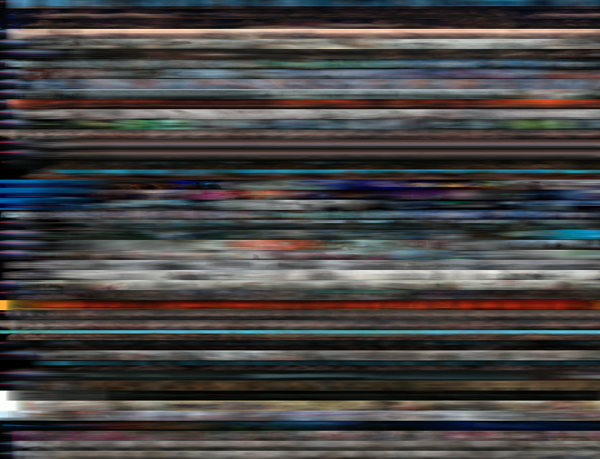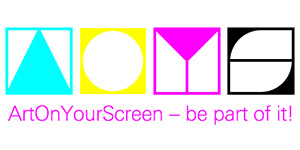Robert M. Ochshorn: Screen Dreams
What is sleep? What is data compression? And what are metadata? And how are these things actually connected? »Screen Dreams« (2014), Robert M. Ochshorn’s poetic title of his work produced for AOYS, makes these connections experienceable in a new way. Figuratively speaking, the work centers on the attempt to teach the computer human abilities and to form memories and recollections while dreaming. Remembering involves ordering and classifying the representation of events. Unlike human beings, this permits the computer to store enormous quantities of information on data in one huge chart. Called a spreadsheet in technical jargon, in calculation programs this facilitates the representation of numbers or relationships between texts. Robert M. Ochshorn uses this method of representation to present his machine to the visitor, the virtual memory, at the ZKM │Center of Art and Media in an entirely unique way, namely, as a huge living worksheet. The data themselves are those files that the institute presented on the Internet as its public, virtual memory. Among others, metadata, play a central role, in other words, information stored in databanks that are saved with the actual file as individualization features. In the case of videos, for example, this could be anything from the date of recording, information on file format, key words on content, persons that may appear, or a film title. In this way Ochshorn undertakes a specific analysis with a very special ZKM Collection, as considered more from the technical perspective than from museum aspects.
The artist experiments with the relationship between mechanical storage and human memory. The idea behind the work is that the human brain uses a hierarchy of processing and abstraction processes constituted of an entire range of levels, in order to construct a meaning of the world from perceptions in the form of a unique symbolic level of consciousness. They are constructed in a bidirectional manner. They can absorb stimuli and reproduce perceptions. One part of the processing occurs during sleep. His experimental setup is based on the premise that dreams are corollaries in the process of memory construction and organization. In the case of human beings, these actively impact on memory, recollection and »order« in »storage«. By contrast, the computer quickly runs up against its own limitations. In distinction to the extremely complicated processes occurring in the human brain during sleep, the computer saves texts, videos, and photographs on a storage media strictly according to fixed rules in files. These remain constant and, are thus essentially of a material nature and inflexible. However, if the dream is a dynamic representation of the reorganization of memory, then the computer requires tutoring. In Ochshorn’s own words: “For the computer to be present in our dreams, its codec must be rewritten.” It must learn to break down the walls between the files.
If this is the case, then what kinds of dreams can a computer dream? In fact, only our own, since, from whom do the data derive? Once we have externalized our memory, in the broadest sense in the form of digital files, indexes and databanks, the question then arises as to how, as a society, we can relive these data as memories when recalling them. For this purpose, Robert M. Ochshorn searches for a special form. He programs a dreaming machine, which dreams our dreams. For this to function, our collaboration is required. It is a dreaming which remains arrested between the banality and the rigidity of viewing entries, namely, the statistical spreadsheets, and the potential expressed in the data reference points, which, in the case of Screen Dreams, is the video collection which the ZKM publishes on its webpage.
In this connection, two concepts play a particularly important role: metadata and compression. As a rule, human endeavors are directed at the control and possession of metadata, since only these guarantee the contact to that which we have externalized as simple data. According to Ochshorn, naked data do not initially possess information. Only by way of metadata does information emerge, and this, says Ochsorn, occurs in two ways: collectively, we treat metadata both as authority, once we have determined them as irrevocable truths, whereas, by contrast, they can serve as the foundation and point of departure for new creative energy.
Compression, on the other hand, as Robert M. Ochshorn describes it, is a kind of faculty of judgment that focuses on salient features: the reduction of repetition and redundancy. Computers require invisible algorithmic compression. They are capable of once again deterministically expanding shrunken files into something similar. Thus, the original no longer exists. Something is dropped: perhaps, an augmented cyclic green pixel in the photograph of a situation in a game of football. In distinction to human beings, compression algorithm is extremely regular. The attenuation of our human memories, by contrast, as these occur in dream, remains unfamiliar to digital storage.
Above all else, we require access to digital compression, as well as to interfaces between man and machine, synopses and synecdoches, which help us acquire access to ever larger catalogues with memories of our pasts, and to interpret these. Screen Dreams uses metadata in a new compression interface by way of video from the ZKM Collection. While the user navigates through Screen Dreams, he creates associations and paths which are, in turn, incorporated in and by Screen Dreams. Ochshorn’s software monitors all user interaction with the machine. His program records every form of digital entry, and while not simply saving them in files, transfers them to processes in a sort of sleep, which then calculates a unifying representation.
| Author: | Matthias Kampann |

